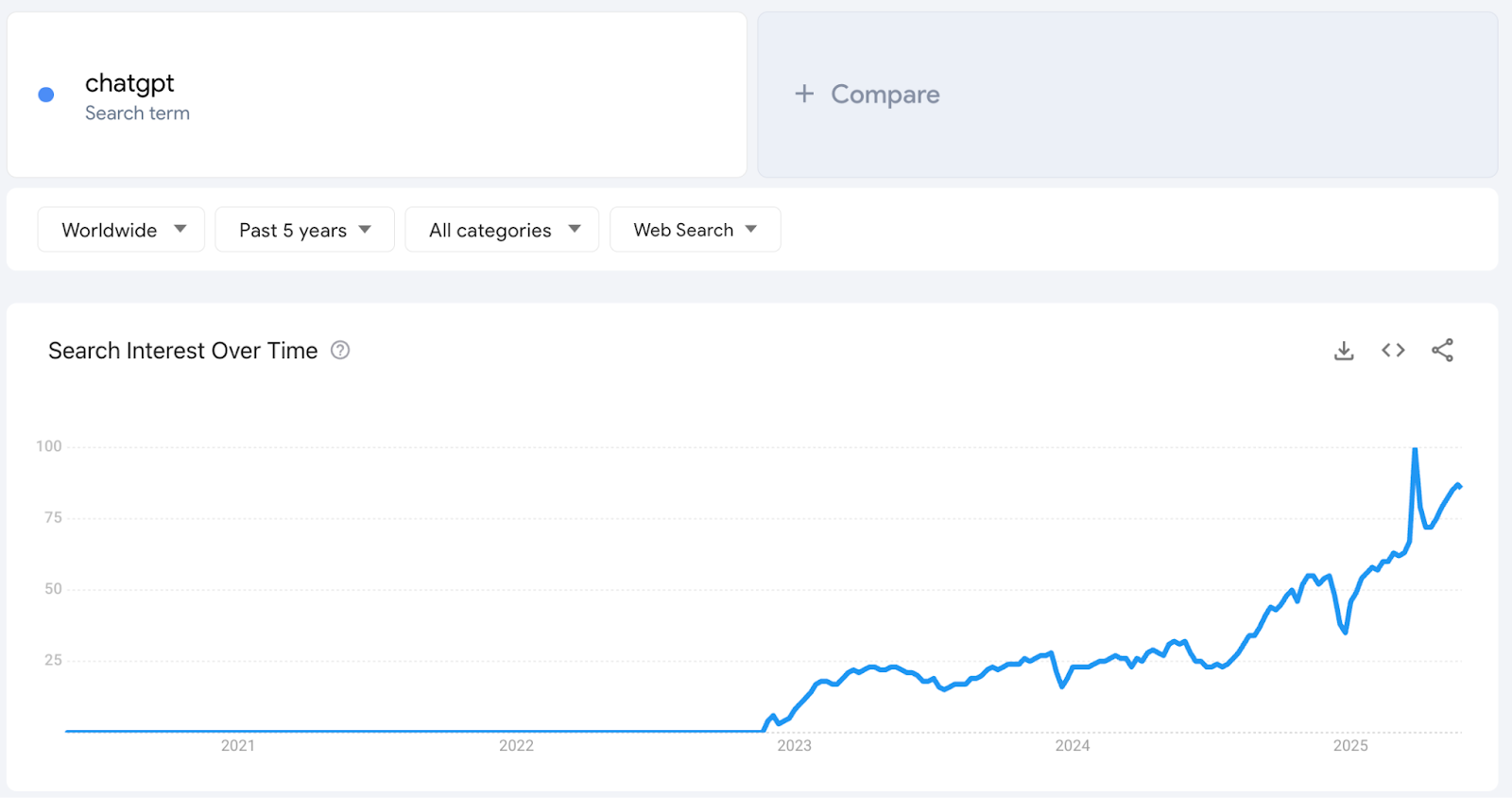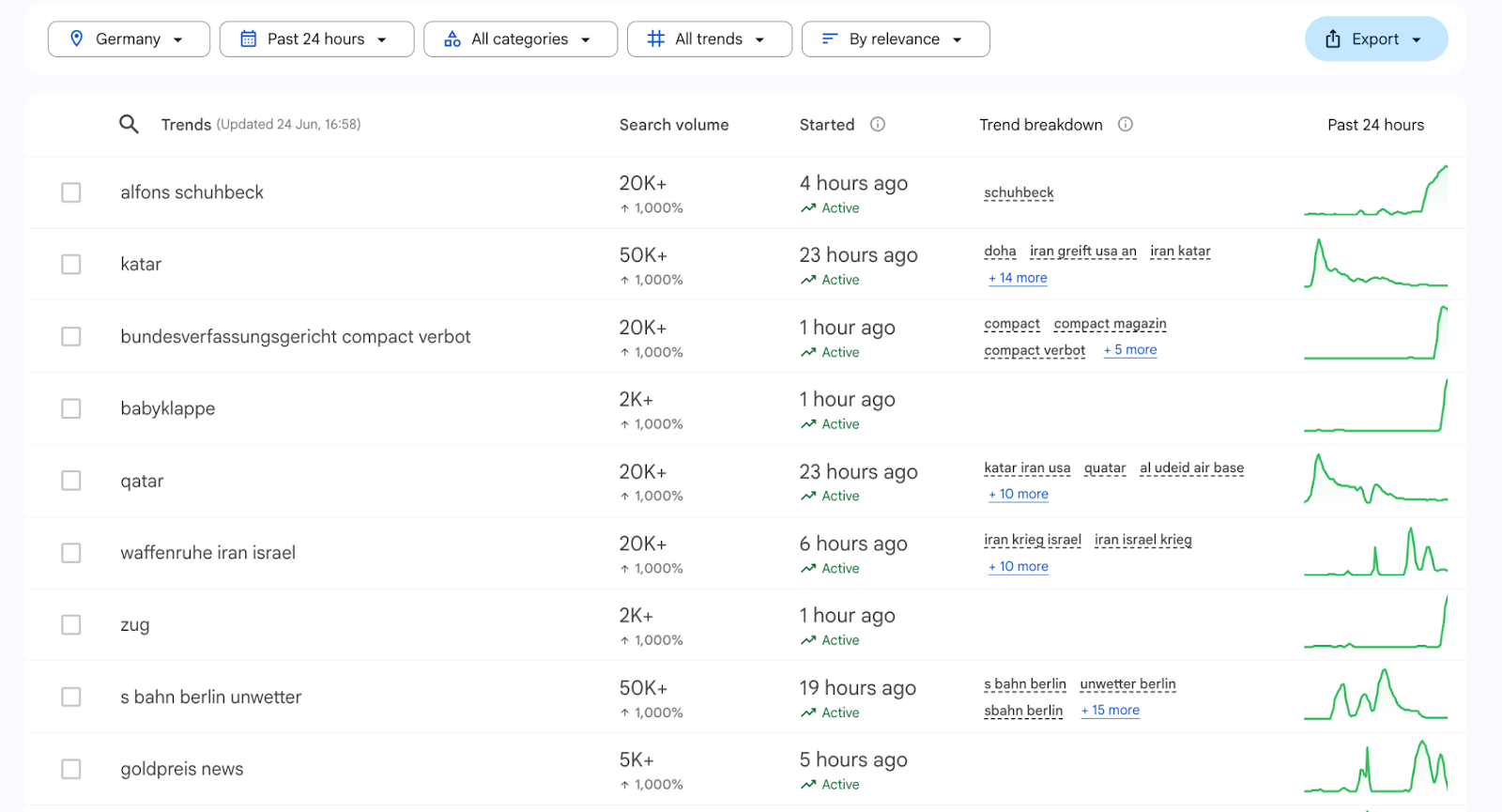
Below we’ll explore six of the best trend discovery tools that serve as great alternatives to Glimpse.
In case you’re in a hurry, here are the main takeaways:
If you’re an entrepreneur or product creator hungry for the next big niche… Rising Trends is a fantastic choice. It combines curated trends with hard data and unique extras like trending apps and niche reports, all at a startup-friendly price. You’ll get plenty of concrete business ideas backed by numbers – perfect for validating that a niche has demand before you dive in.
If you are looking for maximum access to trends data… Glimpse or Exploding Topics will suit you. Both are data-driven trend platforms. Glimpse offers Google Trends superpowers (absolute volumes, extension integration, forecasts) while Exploding Topics gives you a steady diet of curated trending keywords with growth graphs.
If you’re a content marketer or social media strategist… check out BuzzSumo for what’s hot on social. It ensures you’re on top of viral stories and trending content in your field so you can capitalize on them. Supplement that with Google Trends (free!) for quick checks on seasonality and comparisons.
If you need deep consumer insight and a strategic view… Go with TrendWatching (if budget allows) for well-researched reports and frameworks, or Springwise for innovation inspiration with a sustainability twist. These will help you impress in that strategy meeting with not just what is trending, but why it matters and how it connects to bigger shifts.
In this article, we will break down how each tool works, its key features, pricing, and how it compares to Glimpse.
By the end, you’ll have a clear picture of which trend-spotting tool fits your needs best.
Let’s jump in!
1. Rising Trends
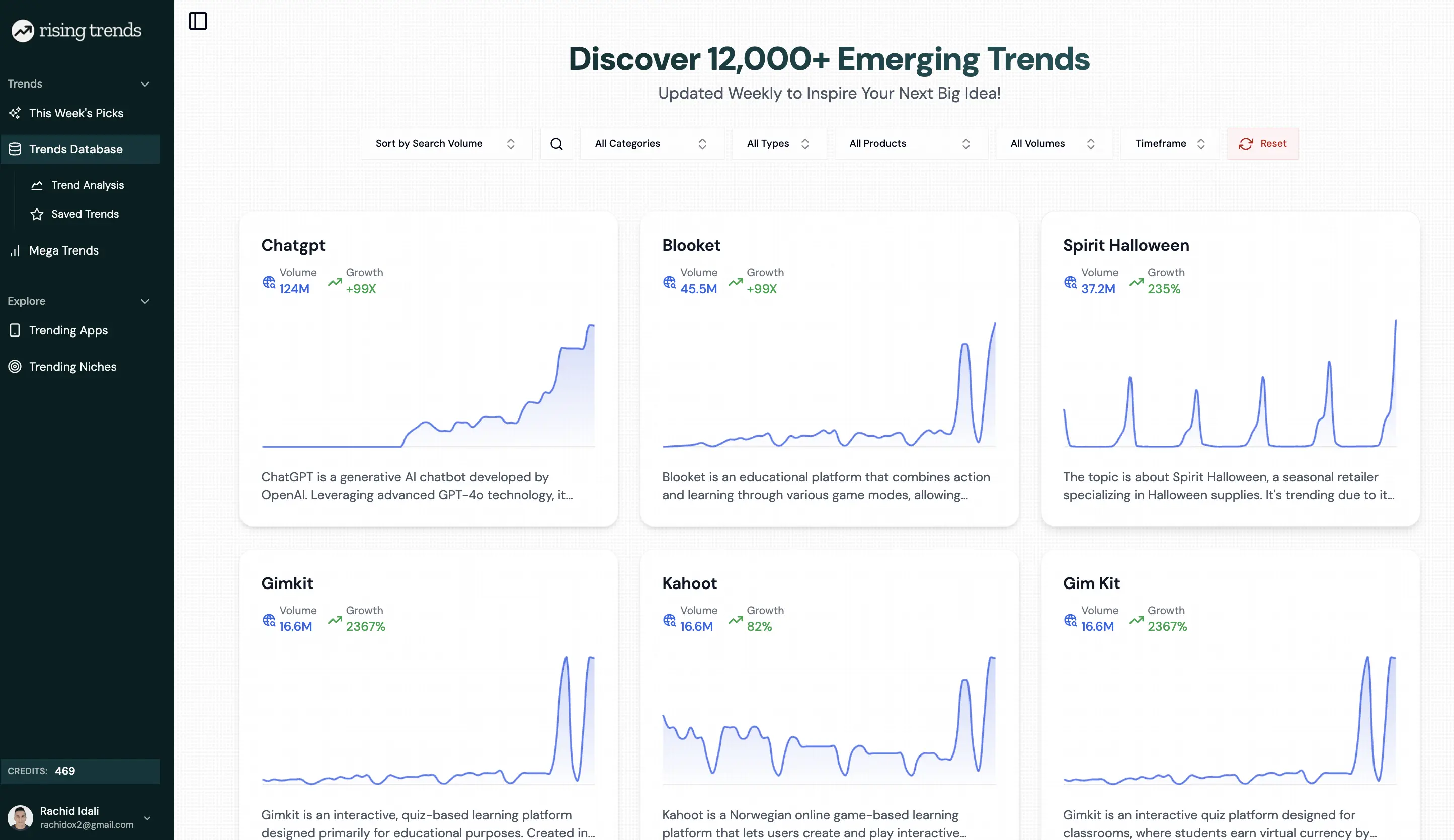
Rising Trends is a top pick for catching business opportunities before they hit the mainstream. This platform is built with entrepreneurs and product creators in mind, emphasizing data-driven insights rather than just cool ideas.
Think of Rising Trends as a hybrid between a trend curator and a market research tool – it not only shows you what’s trending, but backs it up with numbers and context.
Key Features
- Extensive Trend Database: Rising Trends tracks 10,000+ trending topics across industries, and new trends are added weekly. Each trend comes with a five-year Google search volume chart, so you can instantly visualize its growth.
You can filter trends by categories (e.g. fintech, wellness) to focus on your areas of interest.
- Trending Apps: A unique perk is the database of 2,000+ breakout mobile apps . Updated weekly, it highlights new mobile apps climbing the App Store/Play Store charts – something you won’t get from Glimpse or Trend Hunter.
For anyone working in mobile apps, this is gold for spotting the next big product early.
- "Trending Niches" Reports: RisingTrends publishes in-depth niche market reports (around 10–15 available at any time, with 1-2 new added each week).
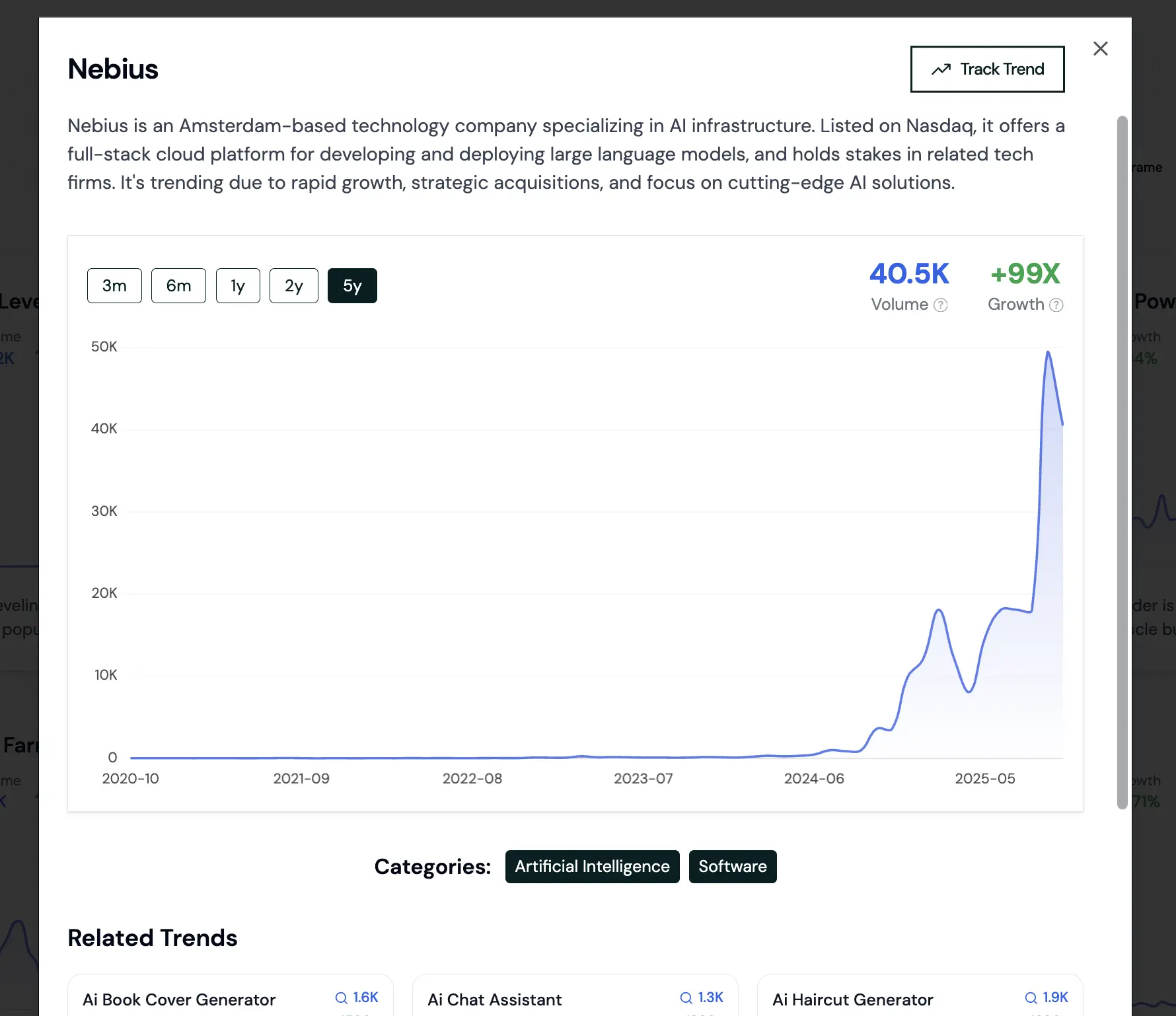
These reports outline fast-growing niche industries with data on market size, key players, consumer pain points, and even business ideas.
It’s like a mini consulting report on why a trend matters. By contrast, Glimpse and Exploding Topics typically don’t provide this level of detailed analysis for each trend.
- Weekly Curated Picks: Every week, a hand-curated top-5 list (e.g. top 5 trending apps, top 5 SaaS trends, top 5 product trends) is delivered. It’s a quick briefing of what’s hot across different areas, which saves you time if you don’t want to sift through the entire database.
It feels a bit like Trend Hunter’s editorial approach, but with a more startup-centric twist.
- Multi-Source Trend Signals: Unlike single-source tools that rely mostly on search data, Rising Trends pulls signals from multiple channels – Google searches, TikTok and Reddit buzz, Amazon sales ranks, app downloads, etc.
This means it can catch a consumer trend wherever it’s growing, not just on one platform. For example, if a product is blowing up on TikTok but hasn’t hit Google’s radar yet, RisingTrends tries to surface it early.
- User-Friendly Interface: The UI is clean and straightforward. Trends are shown as cards with a brief description, a sparkline graph, and stats like monthly search volume and growth rate. It’s easy to sort or filter (by growth rate, category, etc.) and you can save favorite trends to a watchlist.
There’s also a Trend Analysis tool where you can enter any custom keyword to see its 5-year search trend – great for validating ideas you’ve heard about. **
Best For
Entrepreneurs & Indie Hackers: Ideal for those hunting the next startup idea or niche product . RisingTrends is built for this, surfacing under-the-radar opportunities backed by data (so you’re not guessing if a trend has real demand – you’ll see the search volumes and growth percentages).
App Developers: If you build apps, the trending apps databases is invaluable. They can inspire new niche apps or app features by showing what’s gaining traction right now.
Content Creators & Analysts: Bloggers, YouTubers, or trend analysts will appreciate the breadth of industries covered – from tech gadgets to consumer habits. The weekly curated lists and niche reports can spark content ideas and provide context for why something is trending.
Anyone on a Budget: If pricey platforms like Trend Hunter or Glimpse are out of reach, RisingTrends offers a lot of value at a fraction of the cost, plus a generous free option to start.
Rising Trends vs. Glimpse
- Curated vs. Exploratory: Rising Trends provides a curated buffet of trends (with descriptions and context), whereas Glimpse is more of a DIY exploration tool.
With Glimpse, you often start with a keyword or browse their raw trends database; with Rising Trends, many insights (like weekly top trends or niche reports) are presented to you ready-made. For someone used to Trend Hunter’s editorial style, RisingTrends offers a similar “browseable” experience but bolstered by data.
- Data Depth: Both tools leverage Google Trends data, but Glimpse focuses on letting you analyze any specific term deeply (showing absolute search volumes, the ability to compare terms, etc.).
RisingTrends, on the other hand, focuses on breadth of pre-identified trends and gives you data snapshots for each.
For example, if the trend is “AI Voice Generator,” Rising Trends will show its 5-year search graph and growth rate. Glimpse would allow you to dig in further – you could type “AI voice generator” in Glimpse and perhaps get even more granular data or compare it to “text to speech”.
In short, Glimpse is like a microscope for search data; RisingTrends is like a well-organized exhibit of interesting trends.
Unique Features: Rising Trends has those niche reports and curated picks which Glimpse doesn’t offer. Glimpse, meanwhile, has the Chrome extension integration with Google Trends and the ability to enter any keyword to get instant trend stats (essentially supercharging Google Trends). So if you love playing with custom data, Glimpse is powerful. If you prefer the tool to do more of the trend-finding work for you, RisingTrends shines.
Price: RisingTrends is significantly cheaper for full access (as noted, ~$12/mo vs Glimpse’s $49/mo plan for individuals). Glimpse does have a free tier (10 searches per month) and the free extension, but if you need unlimited use, you’ll be paying more per month with Glimpse. For an entrepreneur watching every dollar, that might be a deciding factor.
In summary, RisingTrends is an excellent Glimpse alternative for users who want a mix of hard data and curated insights in one place.
It’s especially geared towards finding business ideas and product opportunities, going a bit beyond what Glimpse provides by answering “why does this trend matter and how can I capitalize on it?”
If you’re the kind of person who likes trend info delivered with context (and you don’t want to spend big bucks), Rising Trends is definitely worth a look.
2. Exploding Topics
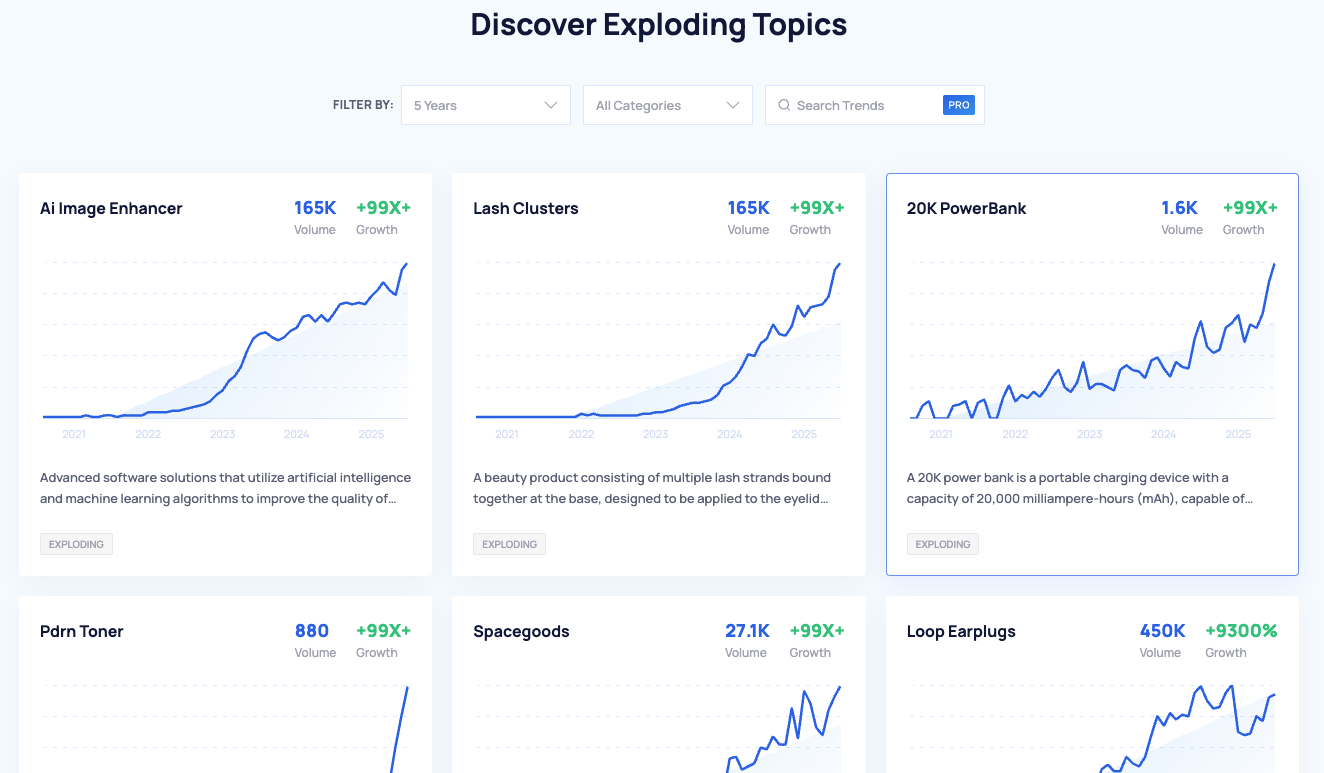
Next up is Exploding Topics – a well-known name in trend spotting, founded by SEO expert Brian Dean (of Backlinko fame) and recently acquired by Semrush in 2024 .
If Glimpse evolved out of Google Trends, Exploding Topics took a different route: it uses algorithms (plus human curation) to find rapidly-growing search trends before they hit the mainstream. It has a sleek interface and is popular among marketers, investors, and product researchers who want to catch the “exploding” trend of the month.
In fact, Glimpse and Exploding Topics have a lot in common in that both give you quantifiable trend data.
The difference lies in how you interact with them: Exploding Topics presents a feed of trending keywords (you discover trends from the tool), whereas Glimpse often has you input keywords (you explore trends through the tool, especially via Google Trends).
Key Features
- Curated Trending Database: The core of Exploding Topics is a database of topics (keywords, products, brands, industries) that are seeing significant upticks in interest. Trends are tagged by status – e.g. Exploding (fast growth), Regular (growing steadily), or Peaked (interest has topped out).
For each trend, you get a short description and a chart of its search interest over time. It’s similar to RisingTrends in presentation, though typically with less contextual detail (Exploding Topics gives you the graph and a one-liner description, not much narrative).
- Meta Trends: Exploding Topics groups related micro-trends into Meta Trends . For example, several rising vegan food product trends might roll up under a meta trend “Plant-Based Protein” with an overview analysis.
This helps you see the forest for the trees – understanding the broader movement behind individual trends.
- Trend Search & Analysis: With Exploding Topics Pro , you can click on any trend to see more data: exact monthly search volumes, related rising queries, and even a basic forecast of future growth.
You can also use a search bar to look up a specific term in their database to see if it’s trending. In a sense, this is like a simpler version of Glimpse’s custom search capability – if the term exists in their database, you’ll get stats on it.
Trend Tracking & Alerts: Pro users can save trends to a personal dashboard to track over time. You’ll get alerts if a saved trend has a noteworthy update (e.g. a sudden spike). It’s like creating a watchlist of trends – useful for investors watching certain niches or marketers tracking a set of emerging keywords.
Daily Updates: Exploding Topics adds new trends daily to keep the feed fresh. Each day you might see a handful of new entries that weren’t there before.
This frequency means you’re always seeing up-to-date info on what’s starting to catch fire. (They’ve mentioned they pull data from sources like Reddit, Google, YouTube, TikTok, etc., not just Google searches, to identify trends – though what you see as output is usually the search volume graph.)
- Semrush Integration: Since the acquisition, Exploding Topics is now integrated into Semrush’s platform. You can access ET through the Semrush interface, and presumably over time they might blend in more data (Semrush’s SEO data, backlink data, etc.).
Right now, the main noticeable change is you need a Semrush login for the trial or pro, and the branding ties into Semrush. It signals that ET may expand its features with more resources behind it. **
Best For
SEO and Content Marketers: If your goal is to identify rising keywords and topics early for content creation or SEO, ET is fantastic. It literally feeds you topics that are about to get big, so you can write that blog post or make that video before everyone else does.
Entrepreneurs & Product Developers: Similar to RisingTrends, Exploding Topics can spark ideas for new products or startups. It tends to lean more tech and web oriented (given its founders’ background), so you’ll find a lot of software, internet, and consumer tech trends that could inspire your next venture.
Investors & Trend Scouts: Many venture capital folks and trend analysts use ET to spot emerging categories or startups to watch. The Investor plan’s focus on startups and the ability to track many trends appeals here – it becomes a radar for what might be the “next big market”.
Fans of Google Trends (who want more): If you’ve spent hours on Google Trends and wished it would just tell you what new thing to search for, ET is your friend. It’s a push-model instead of pull-model: it surfaces queries you didn’t think to ask. In fact, Exploding Topics was built to find what Google Trends might miss , since GT only shows what you enter or very broad “Trending now” news.
Exploding Topics vs. Glimpse
- Pricing: Compared to Glimpse, Exploding Topics’ entry pricing is in the same ballpark – Glimpse starts at $49/mo for unlimited use, ET at $39/mo for a somewhat feature-limited plan.
Neither has a robust forever-free plan (though ET does let you browse some trends without login, whereas Glimpse’s free usage is limited to 10 searches a month). If you’re on zero budget, ET might not work long-term – but many users subscribe for a few months when they need it, then pause.
- Push vs. Pull: The biggest difference is how you use them. Exploding Topics pushes new trends to you – you log in and scroll a list of trending terms in various categories. Glimpse lets you pull data on specific trends – you often start with a term or use its extension while browsing Google Trends.
So if you enjoy discovering trends you weren’t looking for (the “I didn’t know I needed to know this” effect), ET does that. If you have a specific idea and want to vet it deeply (the “I want to analyze this trend” approach), Glimpse is superb for that.
- Google Trends Integration: Glimpse’s killer feature is its Chrome extension that overlays data on Google Trends itself. If you live in Google Trends, Glimpse feels seamless – highlight a term, get instant stats, see real search volumes rather than just 0-100 indexes.
Exploding Topics doesn’t have a browser extension or integration; it’s a standalone platform. So in workflow terms, Glimpse might fit better if your process revolves around Google Trends research.
- Data Sources: Both use web data signals. ET emphasizes multi-channel (search, social, forums) analysis to identify trends, but ultimately presents things in terms of search volume graphs.
Glimpse directly uses Google Trends data (and adds more on top of it). In practice, both will show you a lot of similar trends (there’s overlap), but occasionally one catches something the other hasn’t yet.
For example, Exploding Topics might highlight an emerging slang from TikTok earlier, whereas Glimpse might have a broader set of search-based trends to explore. It’s worth noting that ET updates daily , so it might introduce a trend a bit earlier in its life cycle than Glimpse’s database – but both are pretty quick on catching new trends.
- Quant vs. Qual: Both are quantitative in nature (charts and numbers). Neither gives you the kind of narrative or examples that a Trend Hunter or Springwise would. However, Exploding Topics does have human curation behind the scenes (they manually verify and write a one-line description).
Glimpse is more of an algorithmic toolkit (you won’t get any descriptive text for a trend beyond perhaps the keyword context). If you need a quick description of what a trend is, ET provides that; with Glimpse you might need to do a quick search on the term to understand it.
- Community & Extras: Exploding Topics has a weekly newsletter and some public facing content (they sometimes publish blog posts about trends). Glimpse is more focused on its tool and knowledge base (they have a lot of how-to guides for using Google Trends, etc., on their site). Neither has a community in the way Trend Hunter has user submissions, for instance.
In essence, Exploding Topics is a great alternative or complement to Glimpse if you prefer a steady diet of trend ideas delivered to you , rather than doing ad-hoc analysis from scratch. Many savvy trend analysts actually use them together: e.g. find a trending concept on ET, then use Glimpse (or Google Trends) to dig deeper into that concept’s numbers. (We compare even more tools in our Exploding Topics alternatives guide).
If you have to choose, go with ET if you want a hands-off feed of what’s new across the web, and go with Glimpse if you love getting hands-on with the data for specific queries.
3. BuzzSumo
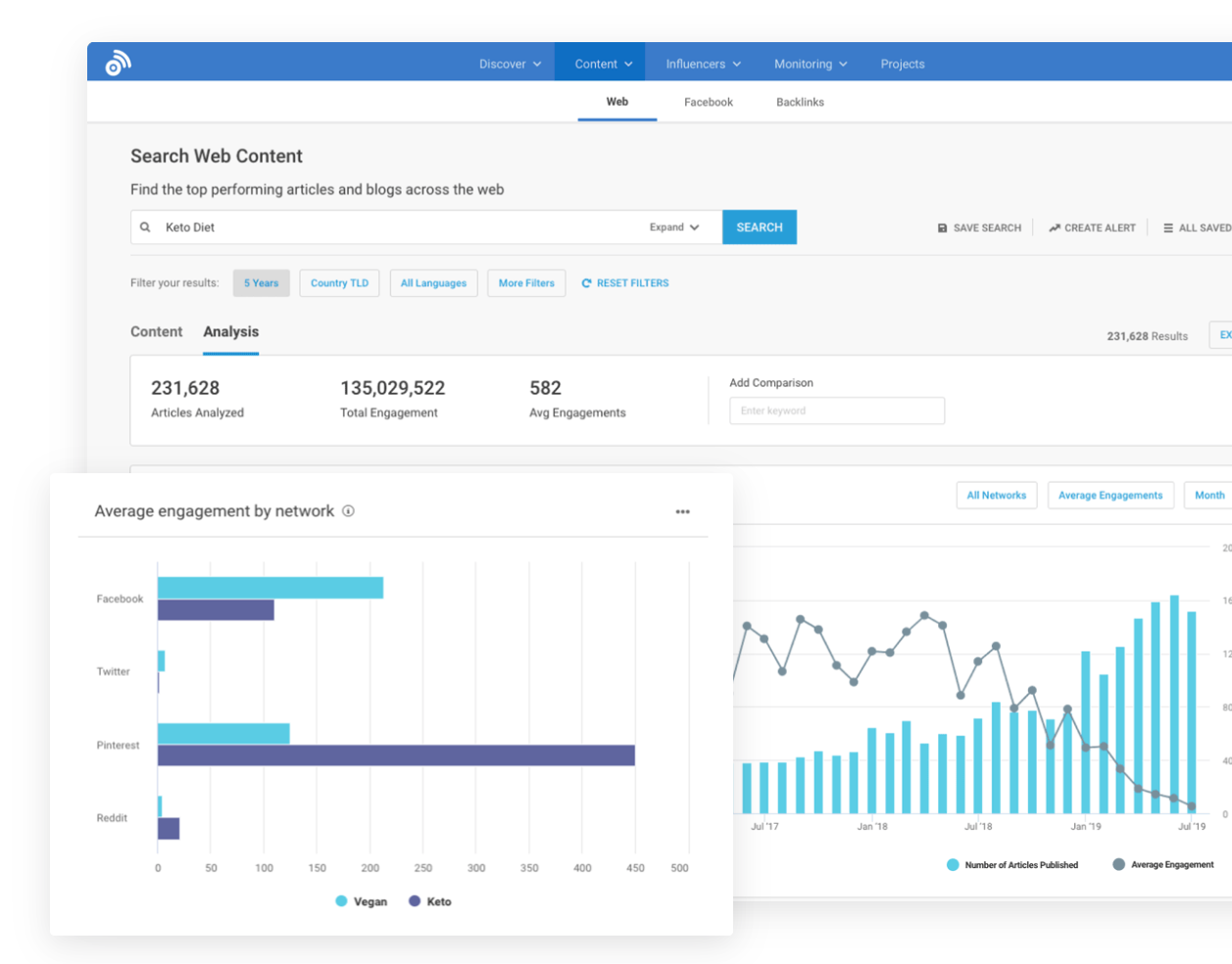
If your focus is on content marketing and social media trends , BuzzSumo is a top alternative to consider. While Glimpse, Exploding Topics, and Rising Trends concentrate on search-based trends or product trends,
BuzzSumo zeroes in on what content is resonating on the web right now . In other words, it helps you find which articles, blog posts, or videos are going viral, and what topics are getting traction across social networks.
This makes BuzzSumo a slightly different beast, but for a content strategist, it’s a trend tool in its own right – it surfaces the trending stories and ideas in real time.
Key Features
- Trending Feeds: BuzzSumo has a section for “Trending Now” content where you can see posts that are blowing up in the last 24 hours, broken down by category (e.g. trending in Technology , Business , Health , etc.). You can also set up custom feeds with keywords.
For example, you could create a feed for “AI” or “Cryptocurrency” to see any new article that’s picking up unusual engagement in that niche. This feed updates continuously, giving you a pulse of very current content trends (often newsy or timely topics).
- Top Content Search: You can search BuzzSumo’s database for any topic or domain to find the most shared content over a given period. For instance, search “sustainable fashion” and BuzzSumo might show that a particular NY Times article about upcycled clothing got 10k shares last month.
This is great for identifying what sub-topics or angles within a theme are engaging people . If you notice multiple top-shared articles all revolve around, say, “plant-based leather sneakers,” you’ve just spotted a trending angle in sustainable fashion. It’s like Google search results, but ranked by social buzz instead of SEO.
- Social Engagement Metrics: For every piece of content, BuzzSumo shows metrics like Facebook engagements, Twitter shares, Pinterest shares, Reddit engagements, number of backlinks, and an overall “engagement score.” This quantifies popularity. For example, you might see an article with 200k Facebook engagements, 5k Tweets, 100 Reddit mentions , etc., all in one view.
This helps you quickly judge how viral something is. (Trend Hunter, by contrast, doesn’t provide such metrics – it just lists ideas. And Glimpse/ET deal with search volumes, not social shares.)
- Influencer & Author Search: BuzzSumo also lets you find key influencers or prolific authors on a topic. If you want to know who’s frequently creating popular content in “vegan recipes” or who the top Twitter voices are in “NFT art,” BuzzSumo can list those.
This is a bit tangential to trend spotting , but it’s useful: following the right influencers can clue you in to trends early, and you might discover trending topics by seeing what these folks are talking about.
Alerts & Monitoring: You can set up alerts for keywords, brand names, or competitor domains. Say you set an alert for “metaverse” – you’ll get notified when new content about the metaverse starts trending, or even when a specific site publishes something on it. This way, you don’t have to keep checking; BuzzSumo will ping you about emerging content trends.
Content Analysis: BuzzSumo provides aggregate insights too (mostly for content strategy): for example, what headlines get the most engagement in a given topic, ideal content length, best day to publish, etc. These aren’t “trend” features per se, but they help you make sense of why certain content trends perform well.
In summary, BuzzSumo acts as a real-time media trends tracker. Its data sources are social media and sharing activity across the web. It’s less about search queries and more about what people are reading, sharing, and talking about today . **
Best For
Content Marketers & Bloggers: If you create content and need to know what’s hot in your niche right now , BuzzSumo is your tool. It ensures you’re on top of viral stories so you can ride the wave (or avoid topics that are over-saturated). For example, a content marketer might use BuzzSumo every morning to see what trending news they can piggyback on for a client’s social post.
Social Media Managers: Similar to above – those who manage brand accounts and need to engage in current conversations. BuzzSumo can alert you to an emerging discussion or a viral article that you might want to reference or respond to.
PR Professionals: It’s great for seeing which stories are gaining traction (to pitch your own angles or just to monitor the media landscape). Also, identifying influential writers covering a trending topic can help in outreach.
Anyone Tracking “Buzz”: If your definition of a trend is “what’s buzzing in public discourse,” BuzzSumo gives you that slice. For example, researchers or analysts might use it to gauge public interest in a topic by seeing how widely content is shared, complementing search trend data.
BuzzSumo vs. Glimpse
- Pricing: Compared to Glimpse (or other trend tools), BuzzSumo’s starting price is high. Glimpse is $49/mo for individuals, Exploding Topics $39/mo – whereas BuzzSumo is $199/mo as a base.
However, BuzzSumo’s value is more niche: if your job is content, that price might be justifiable (and it’s aimed at companies that can expense it). For an individual on a budget, BuzzSumo’s free plan is too limited, and the paid is steep – in contrast, Glimpse or Google Trends might be your go-to for free/cheap trend data.
- Content Focus vs. Topic Focus: BuzzSumo surfaces trending content pieces , whereas Glimpse surfaces trending search topics . For example, BuzzSumo might highlight that “Forbes’ article on VR in education got 8k shares this week,” while Glimpse would show “searches for virtual classroom are up 300% this year.”
BuzzSumo tells you what specific content is popular; Glimpse tells you the popularity of the underlying topic . They overlap in theme but not in format.
- Quant Metrics: Both provide quantitative measures, but different kinds. BuzzSumo gives you social engagement numbers (shares, likes) – a proxy for interest or virality.
Glimpse gives you search volume numbers – a proxy for interest or demand. One might say BuzzSumo quantifies immediate public fascination (people clicking and sharing), whereas Glimpse quantifies informational demand (people actively searching for it). Depending on whether you care about trending conversations vs. trending curiosities, you might favor one metric over the other.
- Trend Horizon: Glimpse (and similar tools) might identify a trend early in its lifecycle (when search is just starting to grow steadily). BuzzSumo tends to show trends at the point they are peaking in virality (lots of shares right now, often tied to news or very timely content).
For example, a meme or viral challenge might explode on social (BuzzSumo picks it up), but it might not have much search volume longevity (Glimpse might not highlight it unless people also search for it).
Conversely, a slow-burn trend like “electric cars” interest may grow in search for years (Glimpse/Google Trends show that), but day-to-day there may not be a single viral article about it (BuzzSumo might not flag anything until, say, a specific Tesla announcement goes viral). In summary: BuzzSumo = shorter-term viral hits; Glimpse = longer-term trend curves (though both can do a bit of the other as well).
- Use Effort: Using Glimpse can be a more casual browse or one-off query activity. Using BuzzSumo effectively often implies you have specific goals or campaigns.
It’s more of an analysis tool, whereas Trend Hunter’s site, for example, you can just scroll for inspiration. BuzzSumo’s interface is straightforward but very utilitarian (lists and filters), so it’s generally used when you need those insights, not just for fun browsing.
In a nutshell, BuzzSumo is a must-have for tracking trends in content and social media. It’s not a direct substitute for Glimpse’s style of trend data (BuzzSumo won’t show you a 5-year graph of a concept’s popularity), but it covers an important angle: what stories and ideas are capturing people’s attention right now .
Many marketers actually pair BuzzSumo with a search-based trends tool: for example, they might identify a rising concept via Glimpse or Exploding Topics, then use BuzzSumo to see if content around that concept is taking off, and how people are talking about it.
If Glimpse answers “what might consumers want next?”, BuzzSumo answers “what are people clicking on and talking about today?” Both perspectives matter depending on your use case.
4. Google Trends
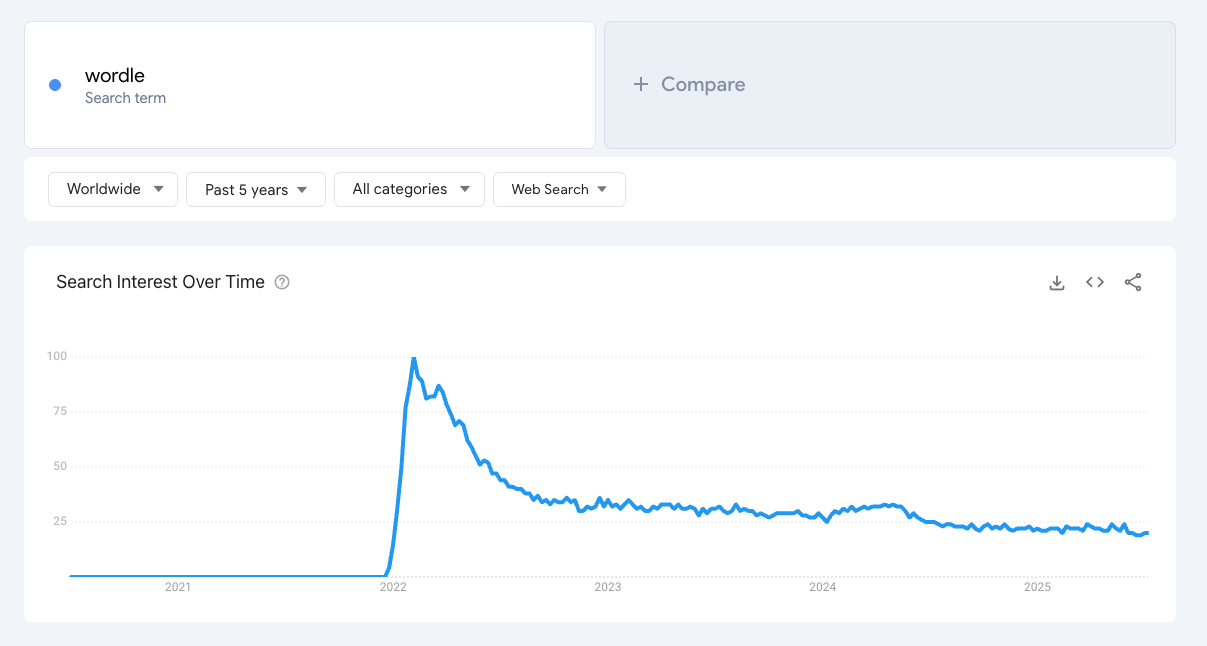
We can’t write about trend tools without mentioning the classic: Google Trends .
This is Google’s own free, publicly available tool for seeing what people are searching for over time.
In many ways, Google Trends is the OG of trend spotting tools – it’s been around since the mid-2000s and offers a simple yet powerful way to gauge interest in a topic.
Now, Google Trends is actually the foundation that Glimpse builds on. Glimpse started as basically “Google Trends on steroids” – it integrates with and adds features to Google Trends. So in considering alternatives to Glimpse, it’s worth considering what vanilla Google Trends offers (and where it falls short).
What Google Trends does well: It shows the relative search interest of any term (or topic) over time, on a 0-100 normalized scale. You can see if a keyword is rising, falling, seasonal, etc., and you can compare multiple terms on the same chart. You can also see which regions search a term the most, and get related query suggestions. It even has a “Realtime Search Trends” section for daily trending searches (mostly news and pop culture).
And the best part: it’s completely free , with no login required. You just go to trends.google.com and start exploring.
However, Google Trends has some limitations – many of which Glimpse and other tools try to solve.
For one, it doesn’t show absolute search volume (only normalized curves). It also won’t proactively tell you “hey, check out this new trending keyword” – you have to type in something you’re interested in. This means Google Trends is fantastic for researching a trend you already know, but not great for discovering trends you don’t know.
Let’s highlight some key aspects:
- Interest Over Time Graphs: This is the signature feature. Type in a query and see its popularity indexed over your chosen time frame (past 7 days, 30 days, 5 years, all the way back to 2004 for some terms).
This quickly shows if interest is rising, peaking, or declining. For example, you can see that searches for “plant-based diet” have steadily grown over the years, or that “fidget spinner” spiked in 2017 and then dropped.
- Geographical Heatmaps: You can see interest by region. If you search a term, Google Trends shows which countries (or states, etc.) search it the most.
This is useful for understanding where a trend is hot. For instance, you might find that “bubble tea” is disproportionately searched in Asia and specific U.S. states with big boba-loving populations. For a marketer, this could guide targeting.
- Related Topics & Queries: When you view a term, Google Trends lists related queries that are rising. Some are labeled “Breakout” if they’ve spiked over +5000%. This often helps you spot sub-trends.
For example, search “NFT” in early 2021 and related rising queries included things like “NFT art” and specific NFT marketplaces – giving you hints at what aspects of the NFT trend were taking off.
- Realtime Trending Searches: On the Google Trends homepage (and a dedicated section), you can see what’s trending today in search. This is typically dominated by news events, celebrity buzz, sports, etc.
For example, during the Olympics, you’ll see which events or athletes are trending each day. While interesting, this feature is more about daily zeitgeist and not as useful for long-term trend spotting (it’s mostly short-lived spikes).
Categories & Search Type Filters: You can filter by category (like Finance, Health, Games) which can help narrow the context of a search term that has multiple meanings. You can also filter by type of search: Web Search vs Image Search vs YouTube Search vs Google Shopping. This can be very insightful – e.g., a term might not be huge on web search but is blowing up on YouTube search (indicating a trend in video content).
Comparison Function: A favorite feature is the ability to compare up to 5 terms on one chart. If you want to see, for instance, “Glimpse vs Exploding Topics vs Google Trends” interest over time (as a fun meta comparison), you can do that. Or compare products: “electric cars vs hybrid cars” to see which is trending higher. This relative comparison is great for benchmarking the scale of trends against each other.
Now, how does Google Trends compare to Glimpse or others?
Google Trends vs. Glimpse
- DIY vs. Enriched Data: Google Trends is like a blank canvas – powerful but you have to do everything yourself. Glimpse takes Google Trends data and enriches it with absolute numbers, growth rates, and extended analytics .
For example, Google Trends might show a line going up to 100; Glimpse would tell you that means 50,000 searches/month and +300% YoY growth. If you’re an SEO or analyst, those numbers are hugely helpful (no more guessing what “100” means).
- Trend Discovery: Google Trends won’t suggest niche trends (aside from the generic daily trending searches). Glimpse, Rising Trends, Exploding Topics etc. are built to surface niche trends for you.
This is probably Google Trends’ biggest drawback for trend hunters: if you don’t know to search for it, you won’t see it . That’s why many people pair Google Trends with other tools that do proactive discovery.
- Data Export & Monitoring: Google Trends has no built-in alert or save feature. You can’t “follow” a term (unless you manually bookmark a URL). Glimpse and others often let you set alerts or watchlists.
Also, Google Trends only provides an API in unofficial ways – whereas tools like Glimpse/ET offer CSV exports or APIs on paid plans. If you need to regularly monitor specific trends, Google Trends alone is a bit manual.
- Depth of Analysis: Google Trends is relatively basic in features. No forecasting (Glimpse has a forecast feature, for example), no sentiment or qualitative insights, no combining multiple related terms (beyond comparing on a chart).
It’s straightforward. This simplicity is actually a pro for quick use, but for heavy analysis you might find it lacking.
- Cost: Google Trends is free – that’s a huge plus. For many casual trend needs, that’s good enough.
If you’re on zero budget, you can actually get pretty far by manually doing Google Trends research: you can find some emerging trends by examining related queries and toggling various categories. It just takes more time and effort.
In summary, Google Trends is a must-have baseline tool. It doesn’t replace Glimpse or others, but it complements them.
In fact, many trend professionals use Google Trends alongside paid tools: for instance, you might discover a trend via Trend Hunter or RisingTrends, then use Google Trends to verify its search interest and compare it to other terms.
Or conversely, you see something spiking on Google Trends daily trends and then investigate it further with a tool like BuzzSumo or Exploding Topics to get more context.
If you’re new to trend analysis, Google Trends is a great starting point. It trains you to think in terms of data (seasonality, relative interest, etc.). As you get more advanced or need more precision, that’s when tools like Glimpse become attractive – essentially giving Google Trends “superpowers.” For a full list of such tools, see our breakdown of Google Trends alternatives.
5. TrendWatching

Moving into the more strategic trend intelligence realm, we have TrendWatching . TrendWatching is a veteran in the trends space.
For a detailed comparison of TrendWatching against other strategic trend tools, see our comprehensive TrendWatching alternatives guide.
They've been around for over a decade (since the 2000s) and are known for their high-level insights into consumer trends and innovations.
Unlike the fast, scrappy vibe of Glimpse or Exploding Topics, TrendWatching has a more consultative, big-picture approach.
Think of TrendWatching as the “management consultants” of trend research . They provide comprehensive reports and frameworks to help businesses not just see trends, but understand why they’re happening and how to act on them.
Key offerings from TrendWatching include their subscription platform (previously called “TrendWatching Premium” or “Amplify” ) which gives you a constant feed of curated micro-trends and innovations, plus a trove of trend reports.
They also do a lot of annual trend predictions, workshops, and even courses on how to think about trends.
Key Features
- Daily Trend “Feed” (via Amplify): Subscribers get access to a feed of the latest micro-trends and innovation examples spotted worldwide, updated daily. This is somewhat analogous to scrolling Trend Hunter or Springwise – you see bite-sized articles about new products or campaigns, each tagged with the trend it represents.
However, TrendWatching’s content tends to be more polished and business-oriented in tone (and not publicly accessible without a subscription). Each item in the feed usually has a short description explaining the innovation and what trend it illustrates.
- Trend Reports & Briefings: TrendWatching is famous for its trend reports , especially their annual report (e.g. “5 Consumer Trends for 2025”). These reports are in-depth, typically covering a handful of major trends with analysis on drivers, case studies, and implications.
For subscribers, there’s a library of hundreds of past reports and monthly briefings. These read like consulting whitepapers – very useful if you need to present to executives or shape strategy around trends.
- “Mega-Trends” Framework: Over the years, TrendWatching has developed overarching themes or Mega-Trends that group smaller trends. For example, a mega-trend might be “Green Pressure” (all about sustainability push from consumers) and under that you might have specific trends like “Eco-nutrients” or “Carbon-naughty” which are quirky names they give to specific phenomena.
This framework helps connect the dots – instead of seeing 100 unrelated micro-trends, you see which bigger shifts they ladder up to. It’s great for strategy folks who need to see the forest rather than just the trees.
- Industry & Regional Filters: Their platform lets you filter trends/innovations by industry or by region. So if you only care about, say, Finance industry trends, or only want to see what’s happening in Latin America, you can do that.
This is useful for corporate users who have a specific focus – something most general trend tools don’t cater to deeply.
- Innovation Database: TrendWatching maintains a database of 1000s of real-world innovation examples (products, services, campaigns), each tagged with relevant trends.
It’s searchable, so you can, for example, search “augmented reality” and see a bunch of examples of how companies used AR in innovative ways. Each example usually has a brief write-up. This database is similar to Springwise or Trend Hunter’s archives, but curated with TrendWatching’s perspective.
- Community and Events: They have a network of “spotters” around the world who contribute examples, and TrendWatching often runs events or offers trend-driven innovation workshops .
They even have an educational arm with courses on how to do trend analysis. All this points to TrendWatching being more than a tool – it’s a service and community around trend intelligence.
Best For
Corporate Strategists & Innovation Teams: If you work in a corporate strategy, innovation, or R&D team and need deep insights into consumer behavior shifts, TrendWatching is ideal. It provides not just what is trending, but analysis on why and what to do about it . For example, a Fortune 500 company’s marketing team might use TrendWatching to get inspiration for their 3-year innovation roadmap, armed with TrendWatching’s reports to justify directions.
Agencies and Consultants: Trend consultants or ad agencies often use TrendWatching to impress clients with well-founded trend insights. The reports and frameworks can be repackaged into client presentations (with proper licensing/attribution of course). It’s a way to bring authoritative trend foresight into your work.
Trend Enthusiasts with a Big Budget: Even an individual can subscribe if they’re really keen, but the price is high. However, some entrepreneurs or small business owners who are very trend-driven might splurge on at least a short-term subscription to soak up knowledge.
Those who need “the why”: If tools like Glimpse tell you what is trending, TrendWatching excels at why it’s trending and how it fits into the bigger picture . It’s almost more akin to reading trend research articles than using a software tool. So if your goal is not just finding a cool product idea but understanding consumer mindset shifts (e.g. “the rise of anti-consumerism among Gen Z” or “the new ecosystem of wellness tech”), TrendWatching is the go-to.
TrendWatching vs. Glimpse
- Pricing: TrendWatching positions itself squarely as an enterprise‑grade insights service: its entry‑level Explore plan costs USD 299 per year (roughly $25 a month, billed annually) for a single user, while a Team subscription starts “from USD 5,999 per year” for larger groups, and anything bigger generally moves into bespoke consulting fees—there’s no always‑free tier, just a short trial, so access to its reports and databases is effectively pay‑walled.
By contrast, Glimpse keeps the barrier far lower: you can run up to 10 searches a month for free, and if you need unlimited usage the individual plan begins at USD 49 per month on a rolling basis. In other words, even Glimpse’s paid option costs less per month than TrendWatching’s cheapest package does for the whole year—and Glimpse lets you test the waters indefinitely without paying, whereas TrendWatching requires an annual commitment once the trial ends.
- Depth vs. Breadth: Glimpse (and similar data tools) can cover hundreds of thousands of micro-trends , but each one is just data on a term. TrendWatching covers far fewer total “trends” but goes much deeper on each one. It’s quality versus quantity.
If you need a quick hit list of 50 trending products, Glimpse can be better here. If you need a 5-page analysis on a societal trend, TrendWatching is your friend.
- Quantitative vs. Qualitative: Glimpse gives numbers (search volumes, graphs). TrendWatching gives narratives and examples. In fact, TrendWatching rarely provides any hard stats in their trend articles – it’s more about consumer insights and case studies.
Neither is heavy on quant in the way Exploding Topics or Glimpse are. So if you want graphs and figures, TrendWatching itself won’t provide those (you might still use Glimpse/Google Trends in conjunction to gather numbers to support a TrendWatching trend). Conversely, Glimpse won’t provide any interpretation or explanation – that’s up to you or something TrendWatching would do.
Actionability: Glimpse is a tool you use to do your own analysis. TrendWatching kind of does the analysis for you and delivers conclusions. For a busy exec, TrendWatching’s output is easier to consume (“Here are the trends and what they mean”). But Glimpse gives you the flexibility to chase any rabbit hole (any keyword or topic) and see if it’s a thing, which TrendWatching won’t unless their team has written about it.
Accessibility: Glimpse has a low barrier (free tier, easy to play with). TrendWatching is behind a paywall and caters to a professional audience. So TrendWatching’s insights might be fantastic, but a startup founder on a shoestring budget might never see them. That’s where cheaper or free tools come in. In fact, many small businesses might use Trend Hunter’s free content or RisingTrends’ affordable plan to get ideas, whereas TrendWatching’s service might be overkill for them.
In summary, TrendWatching isn’t a direct substitute for Glimpse because it operates at a different altitude. It’s less of a “tool” and more of an “insights service.”
However, it’s absolutely an alternative way to get trend insights – especially if you need well-researched, contextualized trends rather than raw data.
Many larger companies use both approaches: they’ll follow high-level reports from TrendWatching and use data tools like Glimpse/Exploding Topics for on-the-ground validation and discovery.
If you’re an individual or small biz, TrendWatching may be beyond scope (both in content and cost). But you can still glean value from their free outputs (sign up for their newsletter, read any free reports they release). And remember, a lot of the “why” behind trends that TrendWatching emphasizes can inspire you to interpret the data you get from other tools more thoughtfully.
6. Springwise
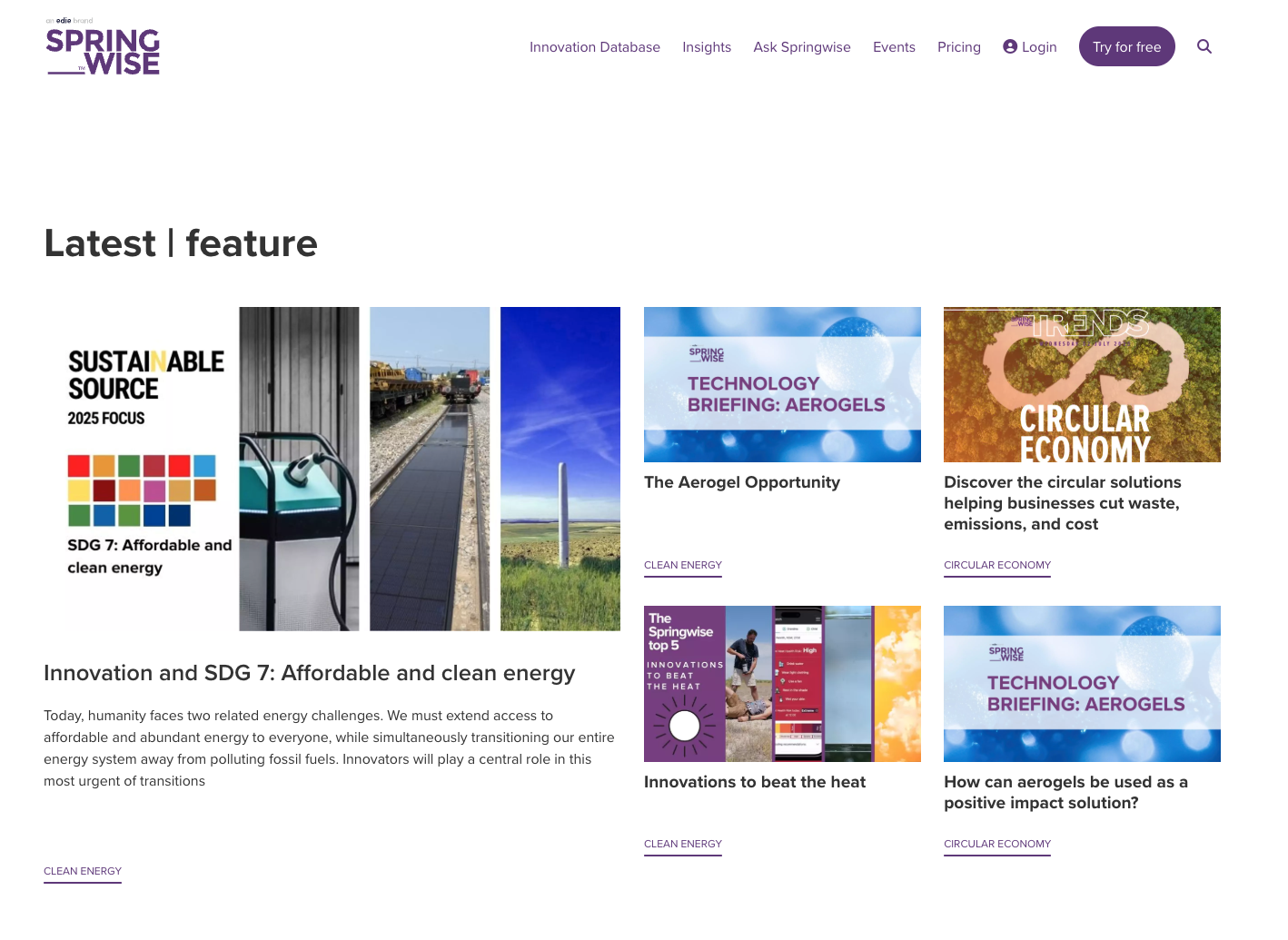
Another long-running player in the trend world is Springwise .
Founded in the early 2000s, Springwise publishes brief articles on new innovations and business ideas from around the globe, with an emphasis on solutions that address real problems (often environmental or social).
In essence, Springwise is an innovation discovery platform . It highlights creative startups, novel inventions, and clever initiatives in various sectors.
For someone looking for trend inspiration with a positive or impact-oriented angle, Springwise is an excellent resource. It’s used by entrepreneurs, sustainability professionals, and corporate innovation teams alike.
Key Features
- Innovation Library (10,000+ articles): Springwise has a vast online library of short articles (roughly 150 words each) describing innovative ideas and ventures from around the world.
These are submitted by a network of contributors and curated by Springwise’s team. Each article usually describes what the innovation is, where it’s happening, and often implies why it’s interesting (though not in a heavy analytical way). You can browse by sectors like Energy, Retail, Healthcare, etc. It’s updated frequently – dozens of new innovations per week.
- Focus on Sustainability & Impact: A distinguishing factor: Springwise highlights a lot of eco-friendly and socially impactful innovations .
For example, you’ll see stories about new recycling technologies, renewable energy startups, water-saving devices for agriculture, inclusive design innovations, etc. They certainly cover general business innovations too, but there’s a noticeable tilt toward “innovation that matters.” This resonates with the increasing trend of sustainability (which many companies are actively seeking ideas in).
- Global Perspective: Springwise prides itself on sourcing examples from all over the world. In one session of browsing you might read about a fintech startup in Kenya, a solar energy innovation in Sweden, and a new retail concept in Japan.
This global reach ensures you’re not just seeing Silicon Valley or Western trends, but truly worldwide innovation sparks.
- Monthly Trend Briefings: For subscribers, Springwise compiles monthly briefings on specific themes.
For instance, a briefing might be “Circular Economy Innovations” where they summarize key developments in that space over the month. These briefs act like mini-reports for those who need a regular digest of trends in a particular area.
- Corporate Services & Consultancy: Springwise has an affiliation with an innovation consultancy called Re_Set . They offer services like custom trend reports, innovation workshops, and even speaking engagements for companies.
So, similar to TrendWatching, Springwise can engage more deeply with clients to help them apply the insights (often around sustainability strategy, given Re_Set’s focus).
- Access Model: Historically, Springwise’s basic content (the articles) has been free to read on their site. You can search and browse without paying. They generate revenue through partnerships, sponsorships, and their consultancy services.
However, in recent times they have introduced more premium offerings (like the live innovation feed or API access for enterprises).
In this Rising Trends article , it was mentioned that full access for enterprises (like integrating their feed internally) was priced at over $5,000 per month with a 12-month commitment – indicating they target large clients for that level of service.
Best For
- Corporate Innovation & Sustainability Teams: If your company has a mandate to be innovative and sustainable, Springwise is a treasure trove. It provides examples of what other companies and startups are doing to solve problems, which can spark internal ideas.
For instance, an automotive company’s innovation team might browse Springwise to see what’s happening in electric mobility or recycling initiatives to get ideas for their own projects.
- Social Entrepreneurs & Impact Investors: Those looking to create or fund ventures that address world challenges will find Springwise inspiring. Seeing many mission-driven business models and technologies can help identify opportunities.
It also helps avoid reinventing the wheel – you might find someone in another country already piloting a solution similar to your idea, which you could learn from or even partner with.
- Educators and Students in Innovation: Professors teaching innovation or entrepreneurship often use Springwise for real-world case examples in class.
Students doing projects on sustainable business ideas can use it as research to see what’s been tried.
- General Trend Enthusiasts (with a purpose lens): Even if you’re just a curious person who likes to know about the latest cool ideas, Springwise is great – especially if you prefer meaningful innovations over, say, the latest TikTok trend. It’s more “future of society” oriented.
Springwise vs. Glimpse
- Curated Stories vs. Data: Springwise gives you stories with images and descriptions. Glimpse gives you data graphs.
If we stick with an example: let’s say the trend is “urban farming”. Springwise might have multiple articles: one about a new rooftop farming startup in Paris, another about an indoor hydroponic system in Singapore. Each tells a story of what’s happening.
Glimpse would simply show you that searches for “urban farming” or “hydroponic kits” have grown X% over 5 years.
So Springwise provides qualitative evidence of a trend (actual projects out there), while Glimpse provides quantitative evidence (interest over time). Both are valuable; together they are even better.
- Topic Range: Springwise leans heavily into certain sectors: sustainability, social impact, tech-for-good. It might not have as much on, say, purely entertainment trends or meme culture – which a platform like Trend Hunter or even Exploding Topics might catch.
If you only followed Springwise, you’d have an excellent view of innovation for good , but you might miss a pop culture shift or a new teen craze that isn’t explicitly solving a problem. Glimpse, being data-driven, will surface whatever people search for – whether it’s a new fashion aesthetic or a new type of solar panel.
- No Metrics Provided: Springwise does not always give you metrics in their articles (no search volume, no engagement stats). They rely on the wow factor of the innovation itself.
Glimpse/Google Trends give metrics but no context. So again, they complement: you might discover an idea on Springwise and then use Google Trends to check if interest in the underlying topic is growing.
- Accessibility: Springwise provides some free content online. Springwise, even as it has premium offerings, still allows free browsing of its article library, which is great for individual users.
Glimpse’s basic usage is free but for deep dives you’d pay. So in terms of cost for just exploring trends, Springwise (free site) + Google Trends (free) is a pretty powerful combo at no cost.
Overall, Springwise is an excellent alternative or supplement to Glimpse if you want a more human, story-driven insight into trends , especially in sustainability and innovation.
It won’t give you numbers or broad trend analytics, but it will give you examples – which are incredibly useful to make trends feel concrete.
Many people use Springwise to get that spark (“oh wow, a startup is doing X”) and then validate the idea’s momentum with a tool like Glimpse or Google Trends (“is the interest in X actually rising globally?”).
Conclusion: One Final Tip
As we’ve seen, there’s no one-size-fits-all in trend hunting. The best Glimpse alternative really depends on what kind of trends you’re after and how you plan to use the insights .
One final tip: mix and match tools for the best results. Savvy trend analysts often use multiple sources to get a well-rounded picture.
For example, you might discover a trend on Springwise, validate its search growth on Glimpse, check its social buzz on BuzzSumo, and read a TrendWatching report to understand the consumer mindset behind it. It sounds like a lot, but each tool adds a layer of insight.
At the end of the day, trend spotting is about seeing patterns and connecting dots. Whether you prefer a visual feast of ideas (à la Trend Hunter), a dashboard of graphs (Glimpse/ET), or a thoughtfully written report (TrendWatching), there’s an alternative here that can elevate your trend-hunting game in 2025.


